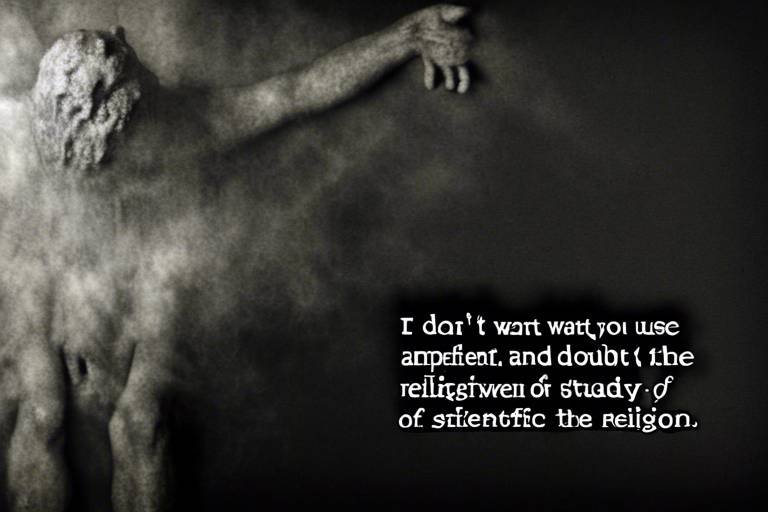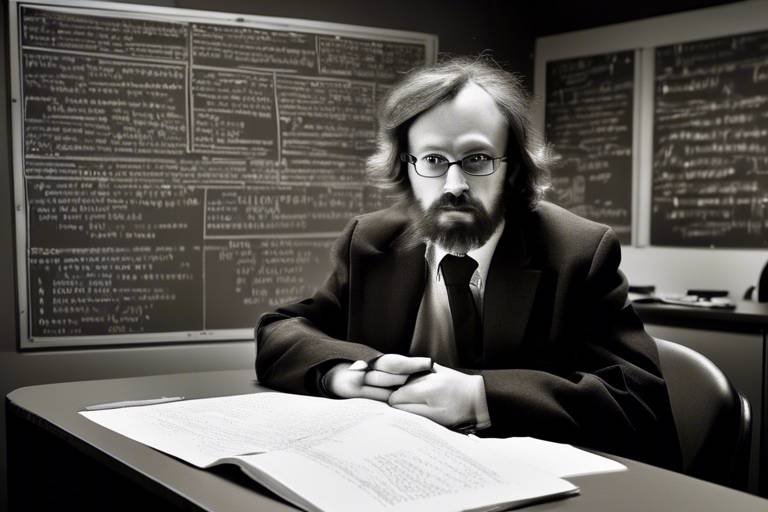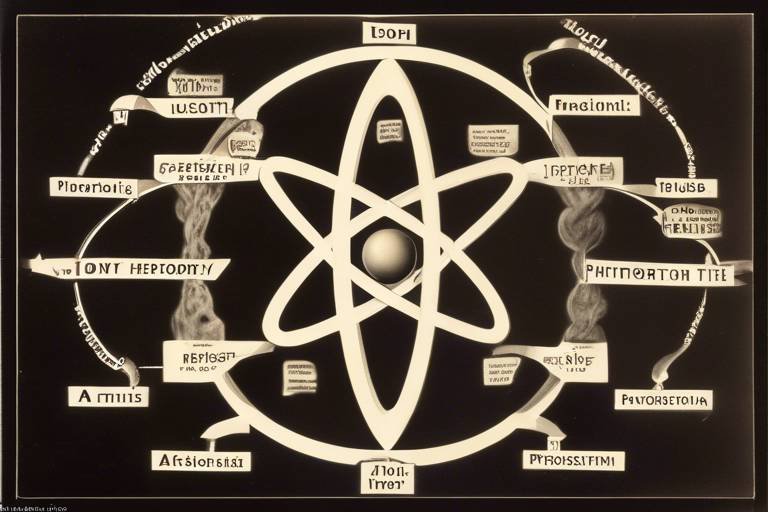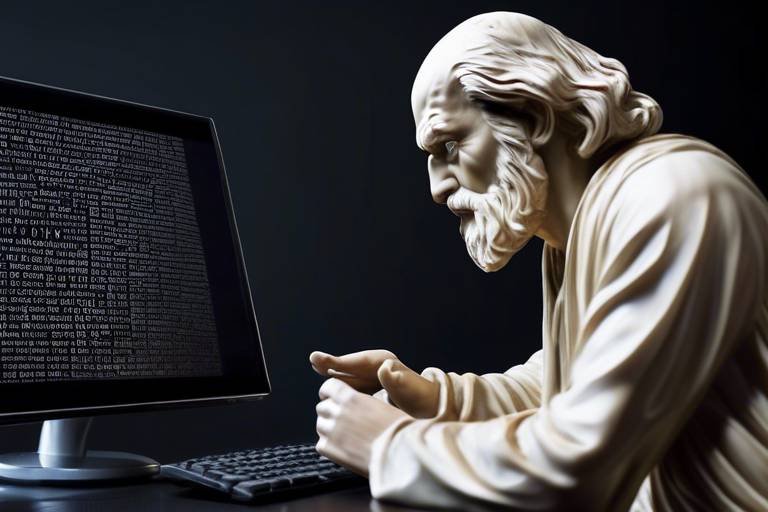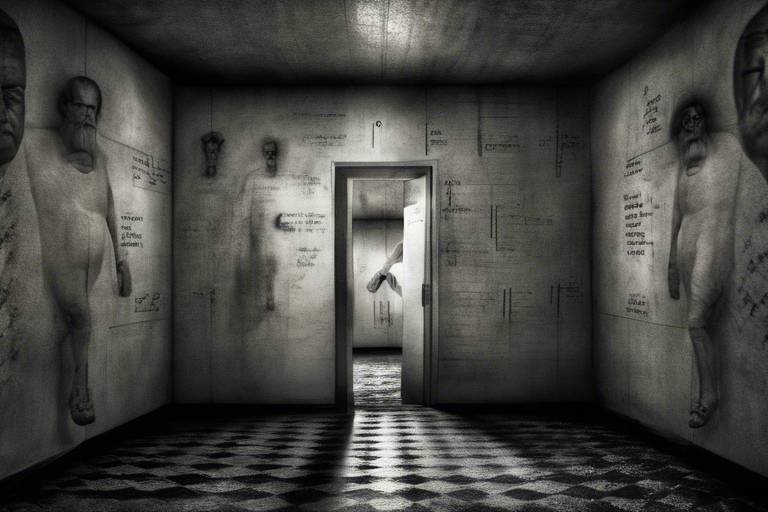Between Faith and Doubt: The Scientific Study of Religion
Religion has always been a fascinating topic, straddling the fine line between faith and doubt. It's a complex tapestry woven from the threads of human experience, culture, and psychology. But what happens when we look at religion through the lens of science? This article embarks on an intriguing journey to explore how various scientific disciplines—like psychology, sociology, and neuroscience—contribute to our understanding of religious beliefs. We aim to dissect the intricate relationship between belief and skepticism, revealing how they coexist and shape our spiritual landscapes.
At the heart of this exploration lies the question: is faith a product of our biology, or is it a social construct? As we navigate this multifaceted subject, we will uncover the psychological mechanisms that underpin belief systems, the sociological factors that influence religious practices, and the neurological responses that accompany spiritual experiences. We will also consider how these elements interact and evolve, creating a rich tapestry of human belief that is both personal and collective.
As we dive deeper, we will see how rituals play a significant role in religious practice. These rituals not only provide structure and meaning but also serve as a vital link between individuals and their communities. They foster a sense of belonging and help solidify shared beliefs. Furthermore, we will touch on the evolutionary aspects of religion, examining how our ancestors might have relied on faith as a survival mechanism. This journey through the scientific study of religion will ultimately lead us to reflect on the future of religious studies and the interdisciplinary approaches that can enhance our understanding of faith and doubt.
Understanding the psychology behind religious beliefs is crucial to grasping the full scope of faith and doubt. Psychological factors, such as cognitive biases and emotional needs, play a significant role in shaping how individuals perceive and practice their faith. For instance, many people experience a cognitive bias known as the confirmation bias, where they tend to favor information that confirms their existing beliefs. This can lead to a strong reinforcement of faith, making it difficult for individuals to entertain doubts.
Moreover, our upbringing significantly influences our religious beliefs. Many individuals inherit their faith from their families, often absorbing beliefs without questioning them. This phenomenon raises an interesting point: can faith be truly genuine if it is adopted without personal exploration? The emotional needs for belonging, security, and meaning often drive individuals to cling to their religious identities, even when faced with doubts. In this way, psychology provides a lens through which we can better understand the complexities of belief.
When we shift our focus to sociology, we see that religion is not just a personal journey but also a social phenomenon. Social structures and cultural contexts heavily influence religious practices and beliefs. For example, individuals often find their faith shaped by the communities they belong to. The interplay between individual faith and community influence can create a robust support system for believers, reinforcing their beliefs while also presenting challenges when doubts arise.
Rituals are a cornerstone of religious practice, serving both psychological and social functions. They provide a framework for believers to express their faith, while also fostering a sense of belonging within a community. The significance of rituals can be seen in various religious traditions, from daily prayers to annual festivals. These practices help individuals connect with the divine and with one another, creating a shared identity that transcends personal doubts.
The relationship between rituals and community bonding is particularly noteworthy. Shared rituals can strengthen group identity, reinforcing beliefs and creating a sense of unity among participants. This communal aspect of religion can be comforting, especially in times of crisis, as it provides individuals with a network of support. However, it can also lead to pressure to conform, making it challenging for individuals to voice their doubts or seek alternative beliefs.
Contrasting individual rituals with communal ones reveals fascinating insights into the nature of faith. While personal rituals—such as prayer or meditation—allow for intimate spiritual experiences, collective rituals emphasize community and shared values. This distinction highlights how personal experiences of faith can differ significantly from collective expressions within religious groups. Understanding this dynamic is essential for comprehending the broader implications of faith and doubt.
Neuroscience adds another layer of complexity to our understanding of faith and doubt. Research has shown that the brain responds differently to religious experiences compared to secular ones. For instance, areas of the brain associated with emotions, such as the amygdala, are often activated during spiritual experiences. This suggests that faith is not merely a cognitive exercise but also a deeply emotional one. Understanding how doubt manifests neurologically can provide insights into the challenges individuals face in their spiritual journeys.
Delving into the evolutionary basis of religion offers intriguing theories on why belief systems may have developed as adaptive mechanisms for human survival. Some researchers argue that religion fosters social cohesion, promoting group survival in early human societies. This perspective raises questions about the fundamental nature of faith: is it an inherent part of being human, or a byproduct of our social environments?
Cognitive science provides valuable insights into how humans naturally form religious beliefs. Concepts such as agency detection—our tendency to attribute intention to events—play a crucial role in how we perceive the world around us. This cognitive framework can lead individuals to interpret life events as being influenced by a higher power, thus reinforcing their faith.
The relationship between religious beliefs and moral reasoning is another fascinating area of study. Faith can significantly shape ethical frameworks, influencing how individuals make moral decisions. This connection between religion and morality raises questions about the nature of ethics: are moral values inherently tied to religious beliefs, or can they exist independently?
As we conclude our exploration, it's clear that the landscape of religious studies is evolving. Interdisciplinary approaches that combine psychology, sociology, and neuroscience can deepen our understanding of faith, doubt, and the human experience. By embracing this complexity, we can gain a more nuanced perspective on the intricate relationship between belief and skepticism. Ultimately, the study of religion is not just about understanding faith; it's about understanding what it means to be human.
- What is the main focus of the scientific study of religion? The scientific study of religion aims to explore the psychological, sociological, and neurological aspects of faith and doubt, examining how they influence human behavior and beliefs.
- How do psychological factors influence religious beliefs? Psychological factors such as cognitive biases, emotional needs, and upbringing play a significant role in shaping religious beliefs, often reinforcing faith while complicating doubt.
- What is the significance of rituals in religion? Rituals provide structure and meaning to religious practices, fostering a sense of belonging and community among believers, while also serving as a personal expression of faith.
- How does neuroscience contribute to our understanding of faith? Neuroscientific research reveals how the brain responds to religious experiences, highlighting the emotional aspects of faith and the neurological manifestations of doubt.
- What are the future directions for religious studies? The future of religious studies lies in interdisciplinary approaches that combine various fields to deepen our understanding of faith, doubt, and the complexities of human experience.

The Psychology of Belief
When we dive into the psychology of belief, we uncover a fascinating web of cognitive processes that shape our religious convictions. Have you ever wondered why some people hold steadfast to their faith while others grapple with doubt? It turns out, our minds are wired in ways that can significantly influence our beliefs. Cognitive biases, for example, play a pivotal role in how we interpret religious experiences. Confirmation bias, the tendency to favor information that confirms our preexisting beliefs, can lead individuals to overlook evidence that contradicts their faith. This psychological phenomenon can create a comforting bubble where doubt is minimized and faith is reinforced.
Moreover, our emotional needs heavily impact the way we engage with religion. Many individuals turn to faith during times of crisis, seeking solace and answers that the chaos of life seems to deny them. Think of it like a life raft in a stormy sea—faith can provide a sense of stability and hope when everything else feels uncertain. This emotional connection can make religious beliefs feel more real and significant, often overshadowing rational skepticism.
Upbringing also plays a crucial role in shaping our beliefs. From a young age, the values and beliefs instilled by our families can set the stage for our spiritual journeys. For instance, children raised in devout households may find it easier to embrace faith, while those in more secular environments might lean towards skepticism. This dynamic illustrates how our surrounding culture and familial influences can create a foundation for our beliefs that may last a lifetime.
Interestingly, psychological research has shown that individuals often experience a cognitive dissonance when their beliefs are challenged. This internal conflict can lead to various outcomes: some may double down on their faith, while others might begin to question and explore alternative perspectives. This struggle between faith and doubt is not just a personal battle; it reflects a broader human experience that has been studied extensively in psychology.
In summary, the psychology of belief is a complex interplay of cognitive biases, emotional needs, and social influences that shape our understanding of religion. As we continue to explore this intriguing realm, we realize that our beliefs are not merely products of rational thought but are deeply intertwined with our emotional landscapes and social contexts.
- What is cognitive bias? Cognitive bias refers to systematic patterns of deviation from norm or rationality in judgment, which can affect our beliefs and decisions.
- How do upbringing and culture influence religious beliefs? Upbringing and culture provide the initial framework for beliefs; individuals often adopt the values and practices of their families and communities.
- What is cognitive dissonance? Cognitive dissonance is the mental discomfort experienced when holding two or more contradictory beliefs, leading to an alteration in beliefs or behaviors to reduce discomfort.

Sociological Perspectives on Religion
The study of religion through a sociological lens offers a rich tapestry of insights that reveal how our beliefs are not just personal convictions but are intricately woven into the fabric of society. Religion, in many ways, acts as a mirror reflecting the values, norms, and conflicts of a given culture. It serves as a powerful social glue, binding communities together while also highlighting the differences that exist within and between them. Understanding this interplay between individual faith and societal influence can help us appreciate the broader implications of religious practices.
One of the key aspects of sociological perspectives on religion is the concept of social structure. This refers to the organized patterns of relationships and institutions that shape our lives. For instance, religious institutions like churches, mosques, and temples are not just places of worship; they are also social organizations that play a significant role in community dynamics. They provide not only spiritual guidance but also social support systems, fostering connections among individuals. These institutions can influence everything from marriage practices to community events, shaping the collective identity of their members.
Moreover, cultural contexts significantly impact how religion is practiced and perceived. In some societies, religion is deeply intertwined with daily life, influencing everything from laws to social norms. In contrast, in more secular societies, religious beliefs may be more individualized, reflecting personal choice rather than communal obligation. This variation raises an interesting question: how does the surrounding culture either reinforce or challenge religious beliefs? The answer often lies in the historical and social contexts that give rise to these belief systems.
Rituals serve as a crucial component of religious practice, providing structure and meaning. They are the tangible expressions of faith that help individuals and communities navigate the complexities of life. From weekly worship services to annual festivals, rituals create a rhythm that punctuates the sacred and the mundane. They can be deeply personal, such as a prayer before a meal, or communal, like a large-scale religious festival that draws thousands together. These practices are vital for fostering a sense of belonging and continuity within a community.
The relationship between rituals and community bonding is profound. When individuals participate in shared rituals, they reinforce their collective identity and strengthen their ties to one another. This communal aspect of religion can be likened to a team sport; just as players rely on each other to achieve a common goal, members of a religious community draw strength and support from their shared practices. The emotional highs experienced during these rituals can create lasting memories and deepen connections among participants.
Contrasting individual rituals with communal ones reveals how personal experiences of faith can differ from collective expressions within religious groups. Individual rituals, such as personal prayer or meditation, may offer solace and introspection, allowing individuals to connect with their personal beliefs. In contrast, collective rituals emphasize unity and shared experiences, often leading to a heightened sense of community. This duality raises an interesting question: how do personal beliefs coexist with collective practices? The answer lies in the dynamic relationship between personal spirituality and communal identity.
Ultimately, sociological perspectives on religion illuminate the complex ways in which faith and doubt are intertwined with social structures and cultural contexts. By examining these relationships, we can better understand the role of religion in shaping not only individual lives but also the broader societal landscape.
- What is the main focus of sociological perspectives on religion?
Sociological perspectives on religion focus on how social structures, cultural contexts, and community dynamics influence religious beliefs and practices. - How do rituals contribute to community bonding?
Rituals contribute to community bonding by providing shared experiences that reinforce group identity and foster emotional connections among participants. - What is the difference between personal and collective rituals?
Personal rituals are individual expressions of faith, while collective rituals involve group participation, emphasizing unity and shared beliefs.

The Role of Rituals
Rituals are more than just a series of actions performed in a specific order; they are the heartbeat of religious practice. In many ways, rituals serve as a bridge between the mundane and the divine, providing individuals with a sense of structure and meaning in their lives. Whether it’s lighting a candle, reciting prayers, or participating in communal celebrations, these acts are imbued with significance that transcends their physical form. They create a shared language among believers, fostering a deeper connection to their faith and to one another. But why are these rituals so essential?
At their core, rituals fulfill several psychological and social needs. They offer a sense of predictability in an unpredictable world, allowing individuals to anchor themselves in something greater than themselves. This anchoring can be particularly comforting during times of crisis or uncertainty. For instance, when faced with loss or change, participating in familiar rituals can provide a much-needed sense of stability. Additionally, rituals often invoke strong emotional responses, which can enhance feelings of belonging and community. Think of it this way: just as a favorite song can evoke memories and emotions, so too can rituals trigger profound feelings of connection to one’s faith and community.
Moreover, rituals play a pivotal role in reinforcing group identity. When individuals engage in shared practices, they are not just participating in a tradition; they are affirming their membership within a community. This collective experience can strengthen bonds and create a sense of unity among participants. For example, during religious festivals, the act of coming together to celebrate can reinforce shared beliefs and values, creating a powerful sense of belonging that transcends individual differences. In this way, rituals become a vital part of the social fabric, weaving together the lives of individuals into a cohesive whole.
To illustrate the multifaceted role of rituals, consider the following table that outlines various types of rituals and their significance:
| Type of Ritual | Significance |
|---|---|
| Personal Rituals | Enhance individual spirituality and reflection. |
| Communal Rituals | Strengthen community bonds and shared beliefs. |
| Life Cycle Rituals | Mark significant life transitions (e.g., births, marriages, deaths). |
| Seasonal Rituals | Celebrate changes in nature and the passage of time. |
In summary, the role of rituals in religious practice cannot be overstated. They provide not only a framework for worship but also a means of connecting individuals to their community and to the divine. Through rituals, believers find comfort, identity, and a deeper understanding of their faith. As we continue to explore the intricate relationship between faith and doubt, it becomes clear that rituals are a vital component of the human experience, offering a glimpse into the profound ways we seek meaning in our lives.

Rituals and Community
Rituals are more than just repetitive actions; they are the heartbeat of a community, a way for individuals to connect with each other and with something greater than themselves. Think of them as the glue that binds people together, creating a shared identity and fostering a sense of belonging. When we participate in rituals—be it a weekly religious service, a holiday celebration, or even a simple family tradition—we're not just going through the motions; we're engaging in a profound expression of our collective values and beliefs.
This connection is especially evident in religious communities, where rituals serve as a framework for social interaction. They provide opportunities for individuals to come together, share experiences, and reinforce their beliefs. For instance, consider a church service where the congregation sings hymns, prays, and listens to a sermon. Each of these elements is a ritual that not only deepens individual faith but also strengthens the community as a whole. The shared experience of worship fosters a sense of unity and purpose, reminding participants that they are part of something larger than themselves.
Moreover, rituals can also play a crucial role in marking significant life events, such as births, weddings, and funerals. These rites of passage serve as communal acknowledgments of important transitions, allowing individuals to navigate their personal journeys with the support of their community. During such times, the presence of others who share similar beliefs provides comfort and solidarity, reinforcing the idea that no one is alone in their struggles or celebrations.
Interestingly, the psychological effects of rituals extend beyond their immediate social functions. Engaging in ritualistic behavior can evoke feelings of safety and stability, especially in times of uncertainty. When individuals partake in familiar rituals, they often experience a sense of calm and reassurance, which can be particularly beneficial in stressful situations. This phenomenon illustrates how rituals not only enhance community bonds but also contribute to individual well-being.
In addition to promoting unity, rituals can also serve as a platform for expressing dissent or questioning beliefs within a community. When members of a group engage in discussions about the meaning or relevance of certain rituals, it can lead to a deeper understanding of their faith and values. This dynamic interplay between conformity and questioning is essential for the evolution of a community's beliefs and practices, allowing them to adapt and grow over time.
Ultimately, rituals are a vital component of any community, acting as both a reflection of shared beliefs and a catalyst for personal and collective growth. They remind us that while faith may be a personal journey, it is often enriched by the relationships we cultivate with others. As we navigate the complexities of belief and doubt, it is within these communal rituals that we find the strength to explore our spirituality and connect with those who walk alongside us on this journey.
- What is the purpose of rituals in a community? Rituals serve to strengthen social bonds, provide structure, and create a shared identity among community members.
- How do rituals impact individual beliefs? Participating in rituals can reinforce personal beliefs, offer comfort during times of uncertainty, and encourage reflection on one's faith.
- Can rituals evolve over time? Yes, rituals can adapt to reflect changing beliefs and values within a community, allowing for a dynamic interplay between tradition and modernity.

Personal vs. Collective Rituals
When we think about rituals, it's easy to picture grand ceremonies, crowds of people, and the powerful energy that comes from collective belief. However, rituals can also be deeply personal, performed in the quiet of one’s own space. Personal rituals often serve as a way for individuals to connect with their inner selves, providing comfort and structure in their day-to-day lives. For instance, someone might light a candle each morning as a way to set intentions for the day, creating a sacred moment of reflection before diving into the chaos of life.
On the other hand, collective rituals are often characterized by their social nature. These rituals can range from community gatherings, like religious services or festivals, to more localized practices, such as family traditions during holidays. They serve not only to reinforce shared beliefs but also to foster a sense of belonging among participants. Imagine a group of people singing together at a church service; the harmony created in that moment transcends individual voices and builds a collective spirit that is palpable.
While personal rituals can be tailored to fit individual needs and preferences, collective rituals often carry the weight of cultural significance. They are steeped in history and shared meaning, which can be vital for community cohesion. To illustrate this contrast, consider the following table:
| Aspect | Personal Rituals | Collective Rituals |
|---|---|---|
| Purpose | Self-reflection, personal growth | Community bonding, shared beliefs |
| Participants | Individual | Group or community |
| Examples | Daily meditation, journaling | Weddings, religious services |
| Flexibility | Highly flexible, personalized | Structured and often traditional |
Despite these differences, personal and collective rituals can complement each other beautifully. For example, an individual who engages in personal meditation may find that their experience is enriched when they later participate in a group meditation session. Both forms of ritual serve the essential human need for connection—whether it’s a connection to oneself or to others. They remind us that while our journeys may be unique, we are all part of a larger tapestry of beliefs and practices that shape our understanding of the world.
Ultimately, the exploration of personal versus collective rituals reveals the multifaceted nature of faith and doubt. Each type of ritual carries its own significance and can impact our spiritual journey in profound ways. By recognizing the value of both, we can cultivate a richer, more nuanced understanding of our beliefs and the communities we inhabit.
- What is the main difference between personal and collective rituals? Personal rituals are individual practices that provide personal meaning, while collective rituals involve a group and often emphasize shared beliefs and community.
- Can personal rituals enhance collective experiences? Yes, personal rituals can deepen one’s connection to collective rituals, making the shared experience more meaningful.
- How do rituals impact our sense of belonging? Rituals create a sense of structure and connection, helping individuals feel part of a community and reinforcing shared values.

Faith and Doubt in Neuroscience
The realms of faith and doubt are not just abstract concepts; they are deeply rooted in the biological fabric of our brains. Neuroscience has begun to unravel the complex relationship between these two states of mind, revealing how our neural pathways influence our spiritual experiences. Have you ever wondered why some people seem to have an unshakeable faith while others grapple with constant doubt? The answer may lie in the intricate workings of our brains.
Research has shown that religious experiences can trigger specific areas of the brain, particularly the prefrontal cortex and the limbic system. These regions are associated with emotion, decision-making, and social behavior. When individuals engage in prayer or meditation, for instance, they often report feelings of peace and connection, which are linked to heightened activity in these brain areas. This suggests that our brain is wired to seek out spiritual experiences, almost as if it craves that connection.
On the flip side, doubt can also manifest in our neurological responses. Studies have indicated that when individuals question their beliefs, it can lead to increased activity in the anterior cingulate cortex (ACC), a region that plays a crucial role in emotional regulation and decision-making. This area becomes particularly active when we encounter conflicting information or face uncertainty, which is often the case when we doubt our faith. It's fascinating to think that the very act of questioning could be rooted in our biology.
Moreover, the interplay between faith and doubt is not just a personal struggle but a communal experience. Neuroscientific studies have shown that participating in group religious activities can enhance feelings of faith through the release of neurotransmitters like oxytocin, often dubbed the "love hormone." This chemical fosters feelings of trust and social bonding, reinforcing the sense of belonging within a religious community. Conversely, when individuals feel isolated or disconnected, their doubts may intensify, leading to a cycle of uncertainty that can be difficult to break.
To further illustrate this relationship, consider the following table that summarizes key findings in neuroscience related to faith and doubt:
| Neural Activity | Associated State | Implications |
|---|---|---|
| Prefrontal Cortex | Faith | Enhanced emotional regulation and connection |
| Limbic System | Faith | Feelings of peace and transcendence |
| Anterior Cingulate Cortex | Doubt | Increased emotional conflict and uncertainty |
| Oxytocin Release | Faith | Strengthened social bonds and community feeling |
In essence, the study of faith and doubt through the lens of neuroscience opens up a whole new world of understanding. It emphasizes that our spiritual experiences are not merely personal beliefs but are deeply intertwined with our biological makeup. As we continue to explore these connections, we may find that the answers to our most profound questions about faith and doubt lie not just in philosophy or theology, but in the very structure of our brains.
- What part of the brain is most active during religious experiences? The prefrontal cortex and limbic system are primarily involved, leading to feelings of peace and connection.
- How does doubt manifest neurologically? Doubt is often associated with increased activity in the anterior cingulate cortex, which deals with emotional regulation and decision-making.
- Can community activities influence faith? Yes, participating in group religious activities can enhance feelings of faith through the release of oxytocin, fostering social bonds.

The Evolution of Religious Belief
The evolution of religious belief is a fascinating journey that intertwines with the very fabric of human existence. Throughout history, humans have sought to make sense of the world around them, often turning to religion as a means of understanding the mysteries of life and death. But why do we believe? What evolutionary advantages might these beliefs confer? Theories abound, suggesting that religion may have developed as an adaptive mechanism, helping early humans navigate their environments and foster social cohesion.
One prominent theory posits that religion emerged as a way to promote cooperation among individuals in small groups. In ancient societies, where survival depended on collaboration, shared beliefs could strengthen bonds between group members, enhancing their chances of survival. This idea aligns with the concept of group selection, where groups with cohesive belief systems outperformed those without, leading to a gradual increase in religious practices over generations.
Moreover, psychological research indicates that humans are hardwired to seek patterns and assign meaning to events. This tendency, known as agency detection, is crucial to understanding the origins of religious belief. Our ancestors, faced with the uncertainties of a perilous world, likely attributed natural phenomena—like storms or the changing seasons—to the actions of unseen agents, which laid the groundwork for the development of deities and spiritual beliefs.
Consider the following table that summarizes key evolutionary theories related to religious belief:
| Theory | Description | Implications |
|---|---|---|
| Group Selection | Religion promotes cooperation and strengthens group identity. | Enhanced survival and reproductive success for cohesive groups. |
| Agency Detection | Humans are predisposed to attribute events to agents or forces. | Formation of beliefs in supernatural beings or deities. |
| Cognitive Byproducts | Religion arises as a side effect of other cognitive processes. | Religious beliefs may not have direct survival value but emerge from complex thought. |
As we delve deeper into the evolution of religious belief, it becomes evident that faith is not merely a relic of the past but a dynamic force that continues to shape human behavior and society. The interplay between our biological predispositions and cultural influences creates a rich tapestry of beliefs that vary across different societies and epochs. For instance, the rise of organized religions can be seen as a response to the complexities of larger societies, where shared beliefs provide a framework for ethical behavior and social order.
Furthermore, the relationship between religion and moral development cannot be overlooked. Many belief systems offer ethical guidelines that promote altruism and community welfare, which are essential for the functioning of any society. This moral framework not only helps individuals navigate their personal lives but also fosters a sense of belonging and purpose within a larger community.
In conclusion, the evolution of religious belief is a multifaceted phenomenon that reflects our innate desire to understand the world and connect with others. As we continue to explore this intricate relationship, we uncover not only the origins of faith but also its enduring impact on human societies. The journey of belief is ongoing, inviting us to question, reflect, and perhaps even redefine what it means to be human in a world filled with uncertainty.
- What are the main theories behind the evolution of religious belief?
Key theories include group selection, agency detection, and cognitive byproducts, each offering insights into why religions may have developed as adaptive mechanisms.
- How does religion impact moral development?
Many religions provide ethical guidelines that shape moral reasoning and community behavior, fostering social cohesion and altruism.
- Is belief in religion a universal trait among humans?
While belief in some form of religion appears to be widespread, the specifics can vary greatly across cultures and societies, influenced by historical and environmental factors.

Cognitive Science of Religion
The is a fascinating field that dives into how our brains are wired to form and maintain religious beliefs. Imagine your brain as a complex network of highways, where each road represents a different thought process, emotional response, or belief system. When it comes to religion, certain routes become particularly well-traveled, shaped by both our evolutionary history and our individual experiences. This section will explore some of the key concepts in this area, shedding light on why humans are inclined to seek meaning through spirituality.
One of the foundational ideas in cognitive science is the concept of agency detection. Humans have a natural tendency to perceive agency in the world around them, which means we often attribute intentions and purposes to events, objects, and even natural phenomena. For instance, when lightning strikes, many cultures might interpret it as a sign from the gods rather than a mere natural occurrence. This inclination to see agency can lead to the development of religious beliefs, as individuals start attributing their experiences and the complexities of life to higher powers or deities.
Furthermore, cognitive science suggests that humans possess an innate need for meaning. Life is filled with uncertainties and challenges, and our brains are hardwired to seek explanations. This quest for meaning often manifests in religious beliefs, as individuals look for answers to profound questions about existence, morality, and the universe. The cognitive processes involved in this search can be likened to a puzzle; we gather pieces of information from our surroundings, experiences, and teachings to create a coherent picture that makes sense of our lives.
Another intriguing aspect is the role of cognitive biases in shaping religious beliefs. Cognitive biases are systematic patterns of deviation from norm or rationality in judgment, and they can significantly influence how we interpret religious experiences. For example, the confirmation bias leads individuals to seek out information that supports their existing beliefs while ignoring evidence that contradicts them. This bias can reinforce faith, making it difficult for individuals to question or doubt their beliefs, even in the face of contrary evidence.
Moreover, the cognitive science of religion also examines how social learning plays a crucial role in the transmission of beliefs. From a young age, we are influenced by our families, communities, and cultures, which shape our understanding of religion. Children often adopt the beliefs of their parents or caregivers, much like they learn language or social norms. This social aspect highlights how religious beliefs are not only personal but also collective, passed down through generations and reinforced by shared experiences.
To summarize, the cognitive science of religion provides valuable insights into why humans are drawn to spirituality and how our brains process these beliefs. By understanding the mechanisms of agency detection, the search for meaning, cognitive biases, and social learning, we can better appreciate the complex interplay between faith and doubt. As we continue to explore this field, we may uncover even more about the profound relationship between our cognitive processes and our spiritual lives.
- What is the cognitive science of religion? It is a field that studies how cognitive processes influence the formation and maintenance of religious beliefs.
- How does agency detection relate to religion? Agency detection is the tendency to attribute intentions to events, leading individuals to perceive divine influence in their lives.
- What role do cognitive biases play in religious beliefs? Cognitive biases can reinforce existing beliefs by filtering out contradictory evidence, making doubt less likely.
- Why is social learning important in religion? Social learning helps transmit beliefs from one generation to another, shaping individual faith within a cultural context.

Religion and Moral Development
The relationship between religious beliefs and moral development is a fascinating area of study that reveals how faith can significantly shape our ethical frameworks. At its core, religion often provides a set of guidelines or principles that dictate what is considered right or wrong. This moral compass can influence individuals from a young age, guiding their decisions and actions throughout their lives. But how exactly does this process unfold?
One of the key aspects of this relationship lies in the teachings that religious communities impart to their followers. Many religions emphasize values such as compassion, honesty, and justice, which can profoundly affect a person's moral reasoning. For instance, a child raised in a faith-based environment may learn the importance of helping others, which can foster a sense of empathy and responsibility. This moral education is not just theoretical; it often translates into real-world actions, as individuals strive to align their behaviors with their beliefs.
Moreover, the community aspect of religion plays a crucial role in moral development. When individuals participate in religious activities, they are not only absorbing teachings but also observing the behaviors of others within their community. This social learning can reinforce moral values, as individuals witness the positive outcomes of ethical behavior in their peers. For example, seeing someone perform an act of kindness during a community service event can inspire others to engage in similar acts, creating a ripple effect of moral behavior.
Interestingly, the influence of religion on morality can also lead to complex dilemmas. As individuals navigate their personal beliefs and the expectations of their religious community, they may encounter situations where their moral convictions are challenged. This tension between personal ethics and communal beliefs can lead to a deeper understanding of morality, as individuals grapple with questions like: "What is the right thing to do?" or "How does my faith inform my actions in this situation?"
Research in this field often highlights the diverse ways in which different religions approach morality. For example, while some faiths may prioritize adherence to specific rules or commandments, others might emphasize the importance of intention and context in moral decision-making. This diversity can be illustrated in the following table:
| Religion | Moral Focus | Key Principles |
|---|---|---|
| Christianity | Love and Forgiveness | Golden Rule, Teachings of Jesus |
| Islam | Justice and Compassion | Five Pillars, Quranic Teachings |
| Buddhism | Mindfulness and Compassion | Four Noble Truths, Eightfold Path |
| Hinduism | Dharma and Karma | Principles of Righteousness, Cycle of Rebirth |
As we can see, the moral teachings across various religions can lead to different but equally valuable frameworks for understanding ethics. This diversity enriches the conversation around morality and encourages individuals to reflect on their own beliefs and practices. In an increasingly interconnected world, recognizing these differences is vital for fostering mutual respect and understanding among diverse faith communities.
Ultimately, the interplay between religion and moral development is a dynamic and evolving process. As individuals continue to explore their faith and its implications for their moral choices, they contribute to a broader dialogue about ethics in society. This ongoing exploration not only shapes individual lives but also impacts communities, fostering a culture of ethical reflection and moral growth.
- How does religion influence moral behavior? Religion often provides a framework of values and teachings that guide individuals in making ethical decisions.
- Can moral values exist independently of religion? Yes, many people develop moral values based on personal experiences, societal norms, and philosophical beliefs, even without religious influence.
- Are all religions the same in terms of moral teachings? No, different religions emphasize various principles and approaches to morality, reflecting their unique beliefs and cultural contexts.
- How do religious communities support moral development? Religious communities often engage in practices that reinforce moral teachings, such as community service, discussions, and shared rituals.

The Future of Religious Studies
As we look toward the future of religious studies, it's clear that this field is on the brink of transformation. The traditional methods of examining faith, doubt, and spirituality are evolving, thanks to the integration of various disciplines such as psychology, sociology, neuroscience, and even technology. This interdisciplinary approach not only enriches our understanding but also opens up new avenues for exploration. Imagine a world where the complexities of belief systems are analyzed through the lens of brain scans, social media interactions, and cultural dynamics—it's both thrilling and daunting!
One of the most exciting prospects is the use of big data in religious studies. With the rise of social media platforms, researchers can now analyze vast amounts of data to uncover trends in religious beliefs and practices. For instance, studying hashtags related to faith can reveal how communities engage with spirituality online, providing insights that were previously unattainable. This quantitative data, combined with qualitative research, creates a richer tapestry of understanding. It’s like having a magnifying glass that allows us to see the intricate details of belief systems as they evolve in real-time.
Moreover, the use of neuroscience in religious studies is set to deepen our comprehension of how faith and doubt manifest in the brain. Researchers are beginning to explore how different brain regions activate during spiritual experiences, leading to groundbreaking discoveries about the neurological underpinnings of belief. This could potentially bridge the gap between science and spirituality, fostering a dialogue that respects both empirical evidence and personal experience. Just think about it: understanding the brain's response to prayer or meditation could revolutionize how we perceive the connection between mind and spirit.
In addition to these advancements, the role of cultural context cannot be overstated. As globalization continues to shape our world, religious studies must adapt to include diverse perspectives from various cultures. This means not only studying major world religions but also paying attention to indigenous beliefs, new religious movements, and the spiritual practices of marginalized communities. By doing so, we create a more inclusive narrative that respects the rich tapestry of human spirituality. It's a bit like assembling a jigsaw puzzle—each piece adds depth and color to the overall picture.
Furthermore, as we embrace technology, the future of religious studies may also involve the creation of virtual reality experiences that allow individuals to immerse themselves in different religious practices. Imagine stepping into a virtual temple, mosque, or church and experiencing the rituals and beliefs firsthand. This could enhance empathy and understanding among individuals from different faith backgrounds, fostering a sense of global community. It’s not just about observing; it’s about feeling and connecting on a deeper level.
As we navigate these changes, one thing remains certain: the dialogue between faith and doubt will continue to be a central theme in religious studies. Scholars will need to grapple with questions such as: How do we reconcile scientific findings with deeply held beliefs? Can faith coexist with skepticism? These inquiries will drive research and provoke thought, ensuring that religious studies remain a vibrant and relevant field.
In conclusion, the future of religious studies is bright and full of potential. By embracing interdisciplinary approaches, leveraging technology, and fostering inclusivity, we can deepen our understanding of the intricate relationship between faith and doubt. This evolving landscape not only enriches academic discourse but also resonates with the human experience, reminding us that spirituality is not just a subject to study, but a profound aspect of what it means to be human.
- What is the role of technology in modern religious studies? Technology helps researchers analyze data and create immersive experiences, enhancing our understanding of faith.
- How does neuroscience contribute to the study of religion? Neuroscience explores the brain's response to spiritual experiences, bridging the gap between science and spirituality.
- Why is an interdisciplinary approach important in religious studies? It allows for a more comprehensive understanding of complex belief systems by incorporating insights from various fields.
Frequently Asked Questions
- What is the relationship between faith and doubt?
The relationship between faith and doubt is complex and often intertwined. Faith can provide comfort and meaning, while doubt can lead to deeper inquiry and understanding. Many people experience a push and pull between these two states, which can influence their spiritual journey and personal beliefs.
- How do psychological factors influence religious beliefs?
Psychological factors play a significant role in shaping religious beliefs. Cognitive biases, such as confirmation bias, can lead individuals to seek out information that supports their existing beliefs. Additionally, emotional needs, like the desire for community or comfort during difficult times, can drive people toward faith.
- What is the importance of rituals in religion?
Rituals are essential in religious practice as they provide structure, meaning, and a sense of belonging. They can reinforce community bonds and individual faith, serving as a bridge between personal experiences and collective expressions of spirituality.
- How does neuroscience contribute to our understanding of faith?
Neuroscience offers insights into how the brain processes religious experiences. Studies show that certain areas of the brain are activated during spiritual practices, highlighting the neurological underpinnings of faith and doubt. This research helps us understand the biological aspects of spirituality.
- What role does culture play in shaping religious beliefs?
Cultural contexts significantly influence religious practices and beliefs. Social structures, traditions, and community values can shape how individuals experience faith, leading to diverse expressions of spirituality across different cultures.
- How do personal and collective rituals differ?
Personal rituals are often intimate and tailored to individual experiences, while collective rituals involve shared practices within a community. Both serve important functions but can evoke different feelings and levels of connection to faith and the community.
- What is the evolutionary basis of religion?
The evolutionary basis of religion suggests that belief systems may have developed as adaptive mechanisms for human survival. These beliefs can foster social cohesion, moral behavior, and a sense of purpose, all of which contribute to the survival of groups.
- How does religion influence moral development?
Religion can significantly shape moral reasoning by providing ethical frameworks and guidelines for behavior. Many religious teachings emphasize values like compassion, honesty, and justice, which can influence how individuals make moral decisions throughout their lives.
- What is the future of religious studies?
The future of religious studies is likely to be characterized by interdisciplinary approaches that integrate psychology, sociology, neuroscience, and other fields. This can deepen our understanding of faith, doubt, and the multifaceted nature of the human experience.

